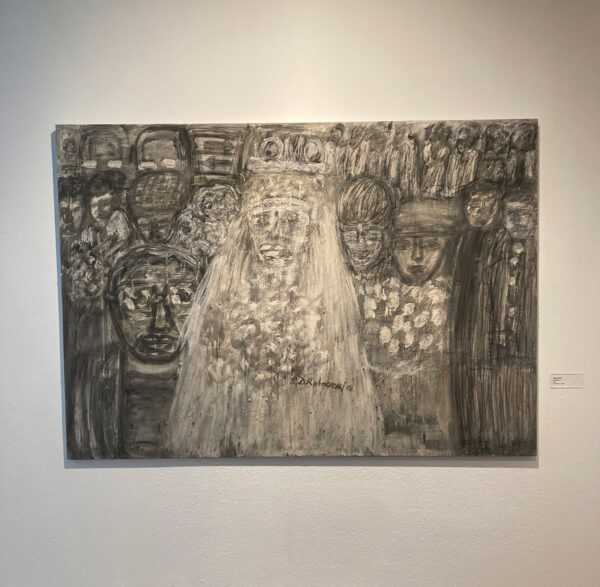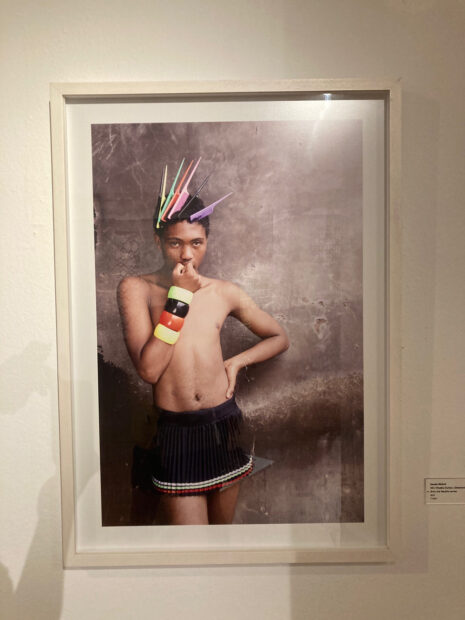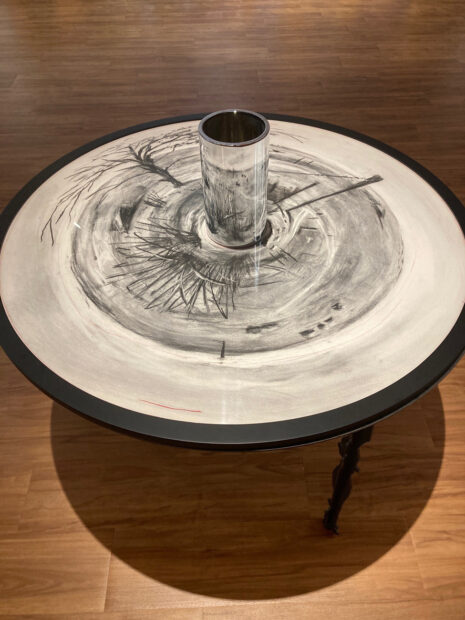Curator Laurie Ann Farrell saw Stephen Hobbs’ print in the Nando’s Art Collection, which reads: “If you look hard enough, you can see your future.” “I really want to implicate the viewers and say ‘our future,’” Farrell told me during an opening reception in April for an exhibition featuring the work at the African American Museum of Dallas. She continued, “The future isn’t just yours or mine, we’re in it together. I’m hoping that people will get a sense of the sort of shared humanity.”
Nando’s is a fast food restaurant that was started in 1987 in Johannesburg, South Africa. In the years since, they have become a global food brand, with over 1,200 locations. The Spier Art Trust, which oversees the company’s art collection of over 25,000 objects, most of which were either made in South Africa or by African artists, helped bring this exhibition to the U.S. In a sense, the show is just a taste of the company: soon, Nando’s will expand to Houston and Dallas; it already has locations in Washington DC, Illinois, Maryland, and Virginia. At the show’s opening, I asked Mirna Wessels, Spier Arts Trust’s CEO, to comment on how the exhibition made its way to Dallas:
“Really for us, it was a time in the collection’s lifespan that it is mature enough to be shown. We were very keen to bring it to North America. It made sense to have it coincide with the Nando’s opening.”
Farrell, who runs Bespoke Art Consultants in Dallas, was approached to curate the exhibition, but the COVID-19 pandemic put things on hold. This gave her some more time to consider how to present the collection for a local audience. About her process, she said, “I got access to the [collection] database and could take my time during lockdown going through all the images. What really became apparent was that they had these strong holdings in portraiture. So I thought, well, I’m just going to build a show around the strength of the collection.”
The exhibition is organized into three themes: portraiture, abstraction, and place. There are a variety of mediums and techniques on view, which speaks to Nando’s interest in showcasing the breadth of South African culture.
The approaches seen in the abstractions gallery are especially diverse. A standout piece on view comes from the collection of the Mercedes-Benz Stadium in Atlanta, for which Farrell curated the art installation. The work, a glass mosaic, was created out of a workshop sponsored by the Spier Arts Trust, designed to train South African locals in the medium. The piece depicts a photo of the American flag being pulled across the stadium’s field after 9/11. (One qualification for the stadium’s art collection was that some works incorporate the Atlanta Falcons’ photographic archive.) The large-scale piece renders color and shadow in a brittle texture, both fracturing and uniting a singular moment in U.S. history, reinterpreted through a South African lens.
Joachim Schonfeldt’s painted scenes from a railway bridge in Johannesburg are contained in wooden circular frames, which are oriented into a pentagon. They depict the industrialization that makes a city feel like a place of progress, and the circular composition insinuates interconnectivity between the various levels of infrastructure, with the composition evoking the curves of transit maps and graphics. The varnish yellows the composition in a way that feels nostalgic for another time.
Kasigo Patrick Mautloa’s painting, City People, Morning Haze makes use of a varying range of realism and caricature, perhaps of commuters bustling about town to and from work.
William Kentridge’s What will come is especially intriguing: the artist drew the composition in a distended toroidal shape, so that when a steel cylinder is placed in the center, it reflects the image, reversing the skewed drawing in a way that is closer to real perspective. The drawing depicts a barren field, save for a tree and some brush. Kentridge’s usual medium, charcoal, loses some of its surface when reflected on the steel tube.
The presence of political commentary in this exhibition gives some context to the social dynamics within South Africa. Vivien Kohler’s Pieta shows a man, clad in blue, laying slack across another man’s lap. The image is painted on a group of Masonite boards that have been collaged with voting posters issued by the African National Congress. In his biography on Sulger-Buel Gallery’s website, Kohler is quoted: “My works do not hide the realities of the unfair perception, but symbolically display it in relation to the liberating verdict of the human spirit.” The shuffled boards composing this piece suggest a vote in process; perhaps there is more work to be done on the project of democracy.
Dallas has many collections on view year-round, but this presentation offers a unique opportunity to see an unlikely partnership between a local museum and a global food brand. It is rewarding to see a collection that is organized by commercial interests which takes the mission of promoting regional art seriously. The African American Museum approaches exhibition programming with creativity, and I hope this show signals that there are future opportunities to bring African collections to Dallas.
If You Look Hard Enough, You Can See Our Future is on view at the African American Museum in Dallas through August 13, 2023.
William Sarradet is the Assistant Editor for Glasstire.







